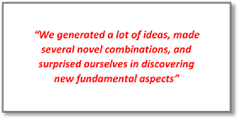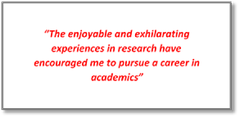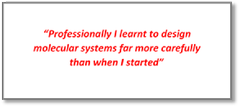 This thesis represents an attempt to explore the possibilities of developing novel platforms in which bacterial cells and recombinant proteins are incorporated in supramolecular biological systems. ‘New ways of developing supramolecular technologies have been explored,’ says Shrikrishnan Sankaran. ‘In parallel projects we generated a lot of ideas, made several novel combinations, and surprised ourselves in discovering new fundamental aspects.’
This thesis represents an attempt to explore the possibilities of developing novel platforms in which bacterial cells and recombinant proteins are incorporated in supramolecular biological systems. ‘New ways of developing supramolecular technologies have been explored,’ says Shrikrishnan Sankaran. ‘In parallel projects we generated a lot of ideas, made several novel combinations, and surprised ourselves in discovering new fundamental aspects.’
 In describing his work Shrikrishnan Sankaran distinguished between three main sections: 1) using bacteria to produce recombinant proteins that can interact with supramolecular hosts and target proteins in a multivalent and multi-specific manner; 2) developing supramolecular platforms that display bioactive ligands in a photo-responsive manner or as gradients to address bacteria as pathogens and 3) genetically engineering bacterial cells with a supramolecular binding motif in an attempt to incorporate them as living entities in supramolecular architectures.
In describing his work Shrikrishnan Sankaran distinguished between three main sections: 1) using bacteria to produce recombinant proteins that can interact with supramolecular hosts and target proteins in a multivalent and multi-specific manner; 2) developing supramolecular platforms that display bioactive ligands in a photo-responsive manner or as gradients to address bacteria as pathogens and 3) genetically engineering bacterial cells with a supramolecular binding motif in an attempt to incorporate them as living entities in supramolecular architectures.
Parallel projects
‘We worked on many parallel projects aiming at generating generic, fundamental knowledge but always with end-applications in mind, likely to actualize in midterm or long-term future,’ he says. ‘Building dynamic and responsive supramolecular platforms, for example, can give rise to powerful new kinds of drug delivery systems and medical treatments. At the same time, these molecules are great tools to study intricate adhesion mechanisms of proteins and living cells to biomimetic surfaces.’

Another challenge was addressed to incorporate bacterial cells as living components in supramolecular architectures. The publication of Sankaran’s 8th chapter, for the ACS Nano Journal, resulted from this work. When designing these systems, self-assembly of carefully selected molecular components was of great importance.
Collaborations
While working on these subjects, Sankaran collaborated with several groups within the University of Twente and at other universities. ‘This is a characteristic of the multi-disciplinary approach used here,’ he says.
Besides using native ESI-mass spectroscopy expertise at the Albert Heck team in Utrecht, and surface plasmon resonance imaging expertise of the Molecular Cell Biophysics group at Mesa+, for analysing self-designed protein complexes, Sankaran also performed experiments using Fluid Force Microscopy (FluidFM) at the renowned Biosensors and Bioelectronics group in Eidgenössische Technische Hochschule (ETH) Zürich.

‘As they were the “inventors” of this fascinating technique, I was able to use their set up straight away to study cell-adhesion forces on supramolecular surfaces,’ he says. ‘These enjoyable and exhilarating experiences in research have encouraged me to pursue a career in academics, for which I have applied for a Rubicon research grant, to perform post-doctoral research work at this very same group in Zürich.’
Balance work/social life
Sankaran stresses the working atmosphere within Mesa+ being favourable, enabling him to develop his skills and contributing to his career development possibilities.
‘The work/social life balance was exceptional,’ he says. ‘I felt at home from the very beginning. By collaborating with fellow-researchers I learnt an immense amount in these four years of PhD work. Professionally I learnt to design molecular systems far more carefully than when I started. I learnt that several parameters are of crucial importance and now I know better to which extent these parameters can be pushed. This field of research holds great potential for the future and a lot of progress can be made.’
